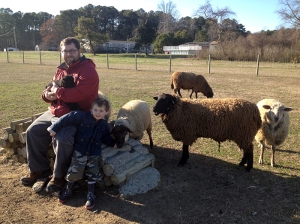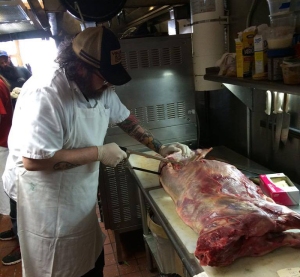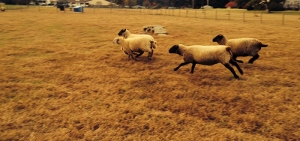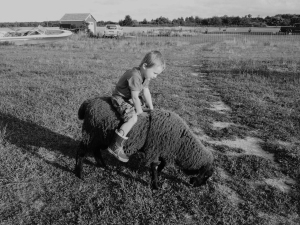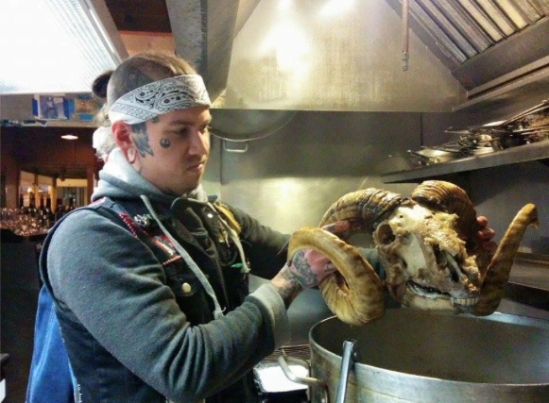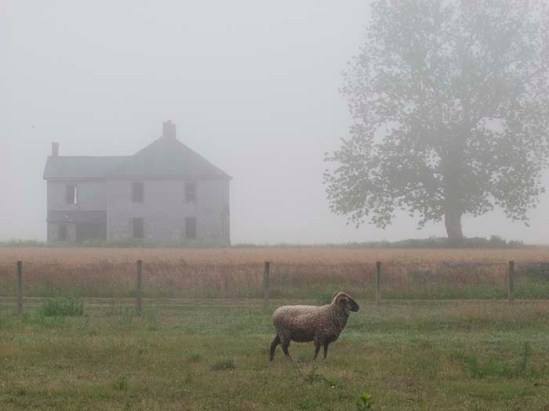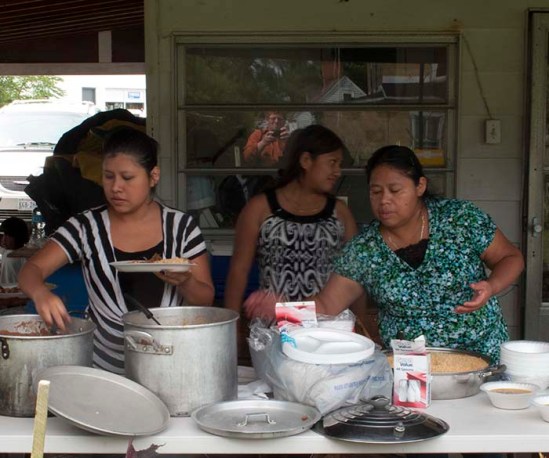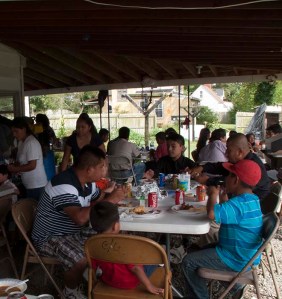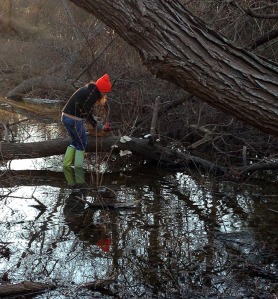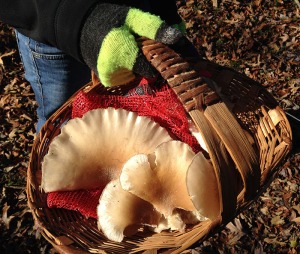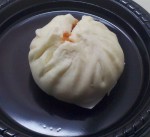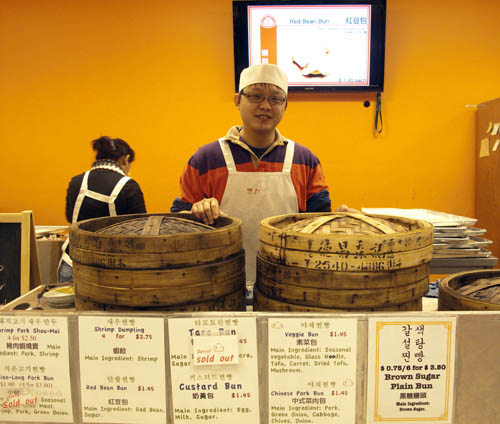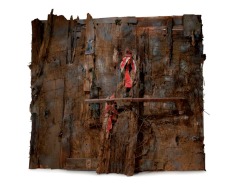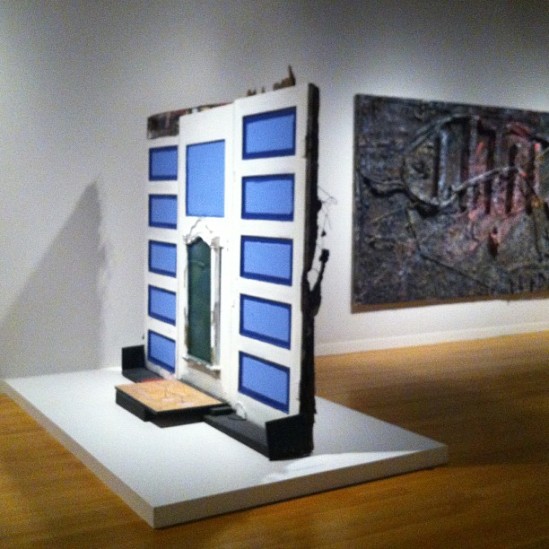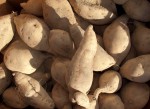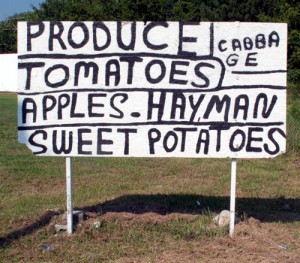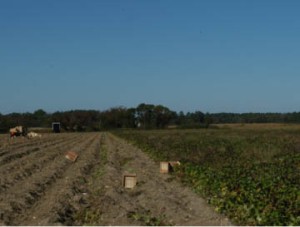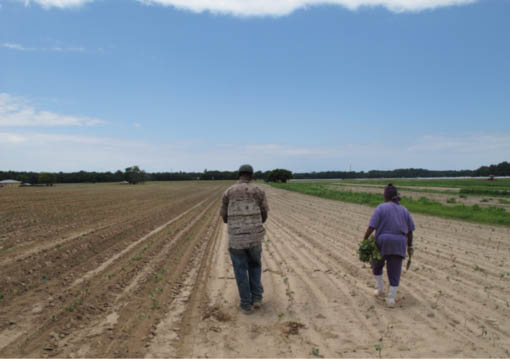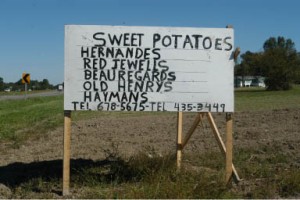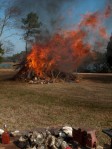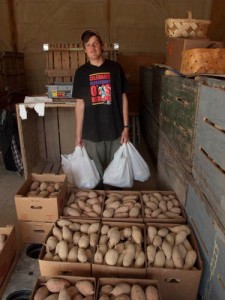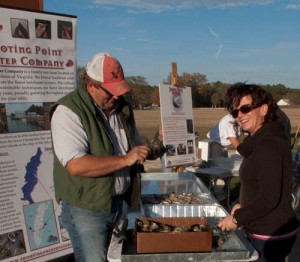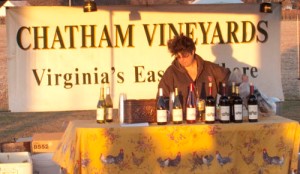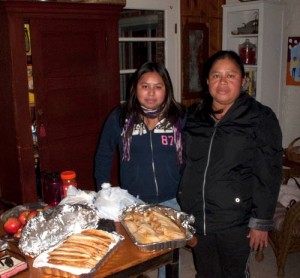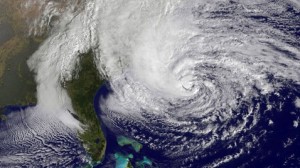One thing leads to another and so it continues with the Hog Island Rare Breed Sheep Guatemalan Barbacoa. The mutton on the plate that lovely afternoon is now an object of veneration and husbandry. A nomination for the Slow Food Movement’s Ark of taste and the restoration efforts of the Lockhart Family Farm chart a path forward for the sheep. The Lockhart’s write that “The Hog Island Sheep is one of only a handful of feral sheep breeds in North America…having been abandoned on the island, the sheep developed a natural hardiness, and a preference for rough forage rather than lush grass…In 2015 we formed a partnership to help bring back the Hog Island Sheep to the table in Virginia. Working with top local chefs and retailers, we expect this to be a mainstay on the menus in Virginia by Fall 2015.” A chef at the center of this endeavor is Travis Milton in Richmond.
Back on the Eastern Shore, Matt Ertle of Island View Farm is working on building a flock for “the new Eastern Shore Artisan Trail Network: promoting and offering educational opportunities about how important sheep were to the shore historically and hopefully in the future as well.” He continues, “We cooked a leg from one of last year’s ram lambs this weekend. My favorite way is to butterfly it, marinate in a mixture of olive oil, Rosemary from my garden, garlic, salt, pepper, and Dijon mustard. Then toss it on my charcoal grill. My family and inlaws that are in town have been working at it for three days now and there still seems to be a little left.” Give me a call, I think to myself. To help in Matt’s, Travis’s, and the Lockharts endeavors (and perhaps reap some future culinary consideration), I put together a brief history of the sheep drawn from a variety of period sources, most notably the online collection of Eastern Shore of Virginia newspapers and periodicals curated by Miles Barnes at the public library. The story, at least for rare breed sheep lovers, is enough to make us realize just how cultivated even the most “natural” landscapes were through the 1800s into the early 20th century.
Hog Island Sheep, the remnant flock of a much larger population formally kept on the barrier islands of Virginia from Assateague to the southernmost tip of the Eastern Shore of Virginia. The sheep ran free until the end of twentieth-century when the last animals were corralled and removed to the mainland. That action concluded a distinctive sheep husbandry that had flourished on the Eastern Shore since at least the mid 1600s and was the object of curiosity from the late 1800s on. From the outset, the Hog island Sheep and their neighbors were kept for wool that could be shipped to urban markets as recorded in a speculative proposition in 1830: “As the price of wool has advanced very much, I hope you have still my wool on hand. It is worth from 25 to 30 c. here & in great demand. We wish you to purchase for us all the wool you can that is fair wool from 15 to 20 c. We will give 20 c. and should you like to join us in speculation we will divide the profits equally. I am sure by a little exertion on Hog Island & else where, we might make a pretty speculation.”[1] Wool was kept as well for local use as recorded in early twentieth-century photographs of island homes. One of those uses likely involved the making of wool or felt “moccasins” worn by local watermen for “treading” clams in marshes. Hog Island, one of the largest in the barrier chain, was described in 1911: “The island is about 10 miles long and the inhabited portion about a mile wide. It has a long and wide stretch of sand dunes and beach. Its pine woods, though reduced in extent by the encroachments of the sand, are still beautiful, and these, together with its myrtle groves and cedar thickets form its distinctive features…In the early years of the settlement the big landed proprietors took up these coast islands. Col. Custis owned Smith’s Island and it has descended from him to Miss Mary Custis Lee, the present owner. Proutt’s [Island] and Cobb’s Islands were owned by the Floyd family and formerly pastured hundreds of sheep and cattle, but are now a waste of sand dunes.”[2] The observations of 1911 echo an 1836 account: “We passed near to a large island, called Prout’s, which is uninhabited, except by flocks of sheep. We had not time to call. This bears almost no trees; and wherever visible from the water, seemed to be but little else than sand hills very scantly covered with weeds or grass. It was said, however, that in the interior there is much of good grazing land. The north-western part of the island, which we approached, is losing greatly by the encroachments of the sea.”[3]
The islands held several advantages for tending sheep. Surrounded by extensive marshes, guts, and creeks , they effectively isolated the animals from the depredations of dogs and other threats found on the mainland. A contributor to the Peninula Enterprise outlined the extent of the problem in 1882: “We find from the United States census report of 1880 that Accomac county [sic.] produced 5,379 fleeces from the sheep raised in 1880… This is sheep country…The grazing and climate are all that could be desired. One thing, and one thing only is in the way of sheep raising — the everlasting ‘yaller dog’ is now, has been, and will be an obstacle, until they are thinned out.[4] The situation remained sufficiently out of control twelve years later when ordinances were introduced into public debate. One of the most heartfelt and pointed pleas in favor of a dog law appeared in the local paper: “The sheep industry here is decayed. Few farmers dare attempt sheep raising because Tray, Blanche, Sweetheart, Brindle, Pug and Little Fancy spread themselves over every acre of land fit to graze, and roaming at will with a taste for racing and mutton forbid the attempt. The hundreds and hundreds of worthless dogs, worth nothing to their owners, an annoyance to neighbors, a foe to sheep, all over the Peninsula, destroy all hope, of raising sheep…We are overrun with [dogs], and seem to have the same superstitious awe of them as the Turks in Constantinople — for they increase fabulously with none to make them afraid or kill them…Put the tax on — a good one — whether the owner likes it or not. Too great interests are at stake to be trifled with by ‘yaller dorgs.’ Sheep-raising can be made profitable here without the mousing pointers and crossfield hounds, that run at will over everybody’s field, but not with them…The case is, Dogs vs. Sheep. We give our verdict, duly considered, in favor of mutton. Tax the dogs out — let the sheep in.”[5] That latter often involved wool pulling and sheep riding inflicted by small boys larking about the fields.
The islands, however, were not entirely safe havens. In addition to the summer torments of heat and biting flies and winter’s biting cold, extreme tides associated with hurricanes and northeasters overwashed the low lying islands with deadly results: “We were visited on Tuesday night last with one of the severest wind storms ever experienced in this section, and unquestionably the highest tide within the knowledge of any one now living, the water reached a point at least 3 feet higher than the great September blow of 1822. . . . On Cedar Island nearly all the stock perished, Capt. O. A. Browne being a heavy loser. His loss there will be fully seventy-five cattle, and as many sheep. . . . No report has reached us from Revel’s [Island] or Hog Island, but on the former, it is feared that Charles M. Dunton, Esq., has lost heavily in stock.[6] A decade later a telegram to Richmond reported: “Intelligence has just reached here from the seaside that seven horses, two hundred sheep, and some cattle, belonging to Powell & Garrison, John A. Brittingham, and others, of Wachapreague, Va., were swept off Parramore’s beach [the island to the immediate north of Hog] during the storm last Saturday night and were drowned.”[7]
Still, barrier island sheep flourished through a passive husbandry that isolated them on islands where they foraged in the native scrub sometimes tended by the occasional resident shepherd. As for the shepherd and his household, they lived in a small dwelling, for example “a little log-built hut, containing but two small rooms. The lower one, half filled by a gigantic bedstead, is used for kitchen, sitting-room, bedroom, and dining-room all in one; the upper, for some mysterious purpose.” [8] The sheep simply wandered. An observer noted in 1907 the sheep on Parramore’s Island between the south end of Cedar Island and the northern tip of Hog: “these animals run wild, and make their own living from the grass, seeds and young shrubs growing on the island, and drink from small pools of land water scattered here and there among the sand hills…The sheep are not used for mutton, but are kept on account of their wool, which is of a superior grade.”[9] Casual experiments in improving the island sheep, notable for their durability in the face of a challenging environment, involved the introduction of other desirable strains into the wild with the expectation that cross breeding would occur in the natural course of events.
Hog Island sheep were rounded up annually for shearing. The most elaborate description of this event appeared in an account penned by Howard Pyle, an artist and occasional local color writer hailing from the Philadelphia area. In 1879, Pyle trekked the length of the Delmarva Peninsula for a three-part travel account that appeared in Harper’s. Pyle’s exploration landed him on Hog Island where he he was hosted by an unreconstructed Confederate veteran: “It was sheep-shearing time, and as we were curious to see not only these island sheep, but the manner of shearing them, we had an excellent opportunity of examining both the one and the other under the pilotage of the owner of one of these islands.” On the day before the shearing, Pyle boarded a “large flatboat, with a leg-of-mutton sail” along with his host, four sheep wranglers, and “a small negro boy” and “the freight of two baskets of ‘grub’, sheep-shears, and a demijohn of water, for rarely any thing but rain-water can be obtained at these islands. The following morning, joined by the shepherd, the crew began their work: “The men started to scour the island over and collect the stray sheep in a flock. They were scattered in all directions, some along the Atlantic surf, some across the marsh, some in the thickets in the southern part of the island. At length the sound of distant bleating was heard, and soon the drove — constantly augmented by the stragglers that joined it from all directions — slowly and reluctantly moved toward the sheep-pen; a moment more and they rushed tumultuously into it.” Pyle elaborated, writing in the idiom of Jim Crow humor, ”The shearing was done on a long table, a carpenter’s work-bench, the small negro being sent into the pen to catch the sheep for the shearers. It was amusing to watch him — the cautious way in which he would approach the frightened drove huddled in a corner, he scarcely less frightened himself. Suddenly he makes a dive, misses his sheep, stumbles, and the whole flock gallops over his prostrate body. Another rush is more fortunate, and he fastens his black little hands in the shaggy wool on the back of some old ram, which drags him, grinning, yelling and with gleaming eyeballs, half around the pen before the animal acknowledges itself conquered. In the afternoon the wind blew up from the northeast and rain set in; the poor denuded sheep, shivering in the cold wind, looked so miserable that B– in very pity stopped the shearing.”[10]
The sheep shearing scene reprised by Pyle achieved a celebratory status for other island communities in an annual cycle of Eastern Shore of Virginia events. The annual sheep penning on Assateague Island, for example, occurred in the first week of June when young men from neighboring Chincoteague would gather, drive the sheep to Sheep Penning Hill, shear the flock, cull out a few for lamb and mutton, and return the rest to graze at large for another year. By the 1880s, the event had evolved into a holiday and tourist draw: “The sheep penning on Assateague, Wednesday, was attended by a large concourse of people, and everything passed off pleasantly. The great feature of the occasion was the attendance of the ‘Led Astray Club’ of Chincoteague. Early in the morning the organization assembled in front of the Capitol Hotel, elegantly attired in their glittering uniforms, said to have been made expressly for the occasion by Worth of New York. The stirring rhapsodies of the Chincoteague string band, led by Prof. Paddock, rung out on the morning air, and at 9 o’clock a. m. sharp, Brig. Gen. Oliver Logan Wimbrough gave the battalion marching orders. The line of route was as follows: Up Broadway to Chestnut street, up Chestnut to Duncan’s Hotel, where the battalion performed some very remarkable feats of drilling, and a copious supply or refreshments were furnished the club. The order forward, march, was again given, and the battalion moved down Chestnut street to Broadway and up Broadway to the post office, where three cheers were given for Boss Mahone.”[11] The marchers then departed for Assateague where they conducted the roundup and shearing.
The consumption of Hog Island Sheep and their island kin as part of the Eastern Shore diet was limited.Bessie Gunter, an Accomack County native and resident who collected recipes from her friends and family, recorded only two recipes in her 1889 Housekeeper’s Companion – both for lamb: “ROAST LAMB. Choose a hind quarter of lamb, stuff it with fine bread crumbs, pepper, butter and a little sage. Sew the flap firmly to keep it in place, rub the outside with salt, pepper, butter, a little of the stuffing, and roast two hours.—MRS. A.T.G.” and “ROAST LAMB. Take a nice tender quarter of lamb, either hind or fore quarter. Salt and pepper it. Put it in a pan with a little water and cook in a quick oven, basting while cooking. All meats and fowl should be well basted while cooking.—Mrs. J.G.F.”[12] The mutton from Hog Island Sheep that I consumed 125 years later was notable for its sweetness and lack of a strong flavor. Travis Milton of Comfort (a Richmond, Virginia, eatery respected for its no-holds-barred no-apologies-offered engagement with Southern foods, inspired by the sheep and the report of barbacoa, secured one of the sheep this spring. His thoughts, he says, contain visions of charcuterie! And, Matt Ertle offered, “I also have a couple of older ewes that could be donated to the cause should there be interest in recreating the barbacoa that sparked your blog post.” Now, there’s a worthy thought.
[1] Thomas U. Teackle, Baltimore, to William B. Upshur, Brownsville, Northampton County, VA (October 6, 1830), Upshur Family Papers William and Mary, Courtesy Miles Barnes, Eastern Shore of Virginia Public Library. [2] Eastern Shore Herald, (October 20, 1911), http://eshore.vcdh.virginia.edu/node/2066 [3] “A Trip to Some of the Sea Islands of Virginia,” Farmers’ Register (1836), 3, http://eshore.vcdh.virginia.edu/node/2107 [4] Peninsula Enterprise (January 19, 1882), http://eshore.vcdh.virginia.edu/node/4262 [5] “To protect sheep and other stock in Accomac and Northampton.” — Senate Bill,” Peninsula Enterprise (January 13, 1894), http://eshore.vcdh.virginia.edu/node/4058. [6] Eastern Virginian, Onancock Virginia (October 26, 1878) http://eshore.vcdh.virginia.edu/node/4200 [7] “Stock Swept to Death — A Citizen Drowned,” Telegram Dispatch, Richmond (April 13, 1889), http://eshore.vcdh.virginia.edu/node/4645 [8] Howard Pyle, “A Peninsular Canaan,” Harper’s New Monthly Magazine, CCCXLVIII (May, 1879), http://eshore.vcdh.virginia.edu/node/1964 [9] “Cedar Island”: The Place for the Tired and Weary, Times-Dispatch, Richmond, Va. (August 25, 1907), http://eshore.vcdh.virginia.edu/node/1939 [10] Pyle (May, 1879), http://eshore.vcdh.virginia.edu/node/1964 [11] Peninsula Enterprise, (June 14, 1883), http://eshore.vcdh.virginia.edu/node/4331 [12] Bessie E. Gunter, Housekeepers Companion (New York: John B. Alden, 1889), 67.




